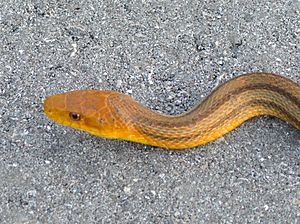Colubroidea facts for kids
Quick facts for kids Colubroidea |
|
|---|---|
 |
|
| Eastern ratsnake (Pantherophis alleghaniensis) | |
| Scientific classification |
|
| Kingdom: | Animalia |
| Phylum: | Chordata |
| Class: | Reptilia |
| Order: | Squamata |
| Suborder: | Serpentes |
| Clade: | Colubroides |
| Superfamily: | Colubroidea Oppel, 1811 |
| Families | |
|
|
Colubroidea is a very large group of snakes. It includes many different kinds of snakes, like the ones you might see in your backyard or at a zoo. These snakes are part of a bigger family tree of snakes called Colubroides. Scientists are always learning more about how these snakes are related to each other.
Long ago, the Colubroidea group used to include other famous snakes like cobras and vipers. But now, scientists have sorted these snakes into their own separate, but still related, families. Today, Colubroidea mainly refers to a big family called Colubridae and its close relatives.
Contents
What are Colubroidea Snakes?
The Colubroidea group is like a giant family reunion for many snakes. It's a "superfamily," which means it contains several snake families. The main family in this group is called Colubridae. This family is huge and includes many common snakes found all over the world.
Some scientists think that the Colubridae family is so big that it should be split into several smaller families. This helps them understand the snake family tree better. No matter how they are grouped, all these snakes are part of the amazing Colubroidea superfamily.
Snake Families in Colubroidea
Scientists often group snakes into families and subfamilies. Here are some of the main groups usually found within Colubroidea:
- Family: Colubridae
- Subfamily: Grayiinae
- Subfamily: Calamariinae
- Subfamily: Ahaetuliinae
- Subfamily: Colubrinae
- Subfamily: Sibynophiinae
- Subfamily: Natricinae
- Subfamily: Pseudoxenodontinae
- Subfamily: Xenodontinae
- Subfamily: Dipsadinae
Sometimes, these subfamilies are even considered full families by some experts. It just shows how much scientists are still discovering about snake relationships!
Mystery Snakes (Incertae Sedis)
There are also some snake types that scientists aren't sure where to place in the family tree yet. They are called incertae sedis, which means "of uncertain placement." These are often snakes known from fossils or those that haven't been studied enough genetically. They are thought to be colubroids because of how they look.
Here are a few of these mystery genera:
- Blythia
- Elapoidis
- Gongylosoma
- Lycognathophis
- Oreocalamus
- †Paraxenophis
- †Periergophis
- Poecilopholis
- Tetralepis
Ancient Colubroidea Snakes
Scientists learn a lot about snakes by studying their fossils. Fossils are the remains of ancient animals preserved in rocks. By looking at these fossils, we can understand how Colubroidea snakes have changed over millions of years.
Fossils in North America
Many Colubroidea snake fossils have been found in North America, especially in Mexico. These fossils help us piece together the history of snakes on this continent.
Some of these fossils date back to the Pleistocene and Pliocene epochs. For example, fossils of snakes like Pituophis (gopher snakes) and Lampropeltis (kingsnakes) have been found. These discoveries show that these types of snakes have been around for a very long time.
Fossils in South America
South America is another important place for finding ancient Colubroidea snake fossils. These finds give us clues about how snakes spread across the continents.
Fossils from the Miocene and Pliocene periods have been found in countries like Colombia, Brazil, Bolivia, and Argentina. These discoveries include remains of various Colubroidea snakes. They often appear alongside fossils of other animals, like ancient turtles, crocodiles, and even early mammals. This helps scientists understand the ancient environments where these snakes lived.

